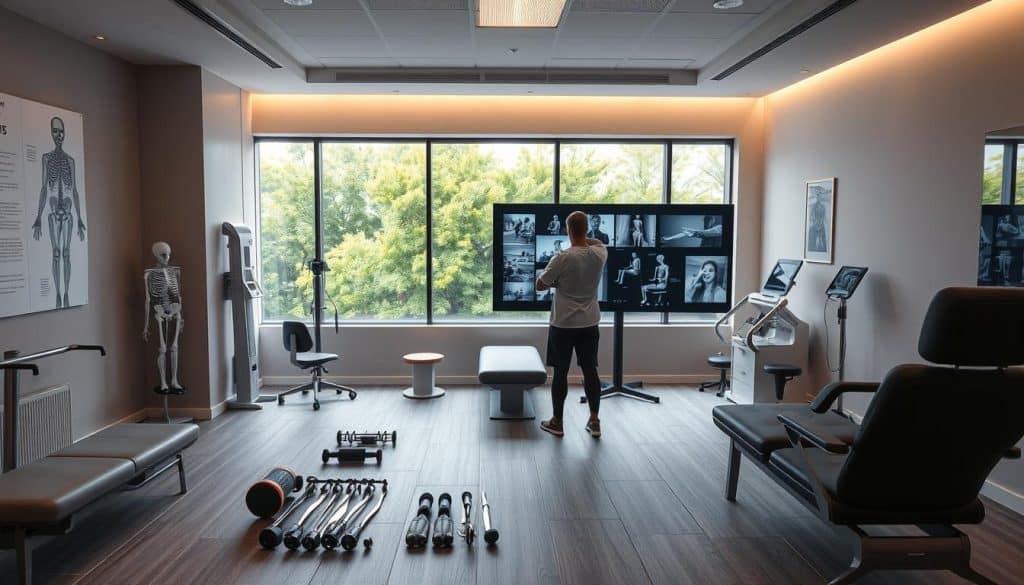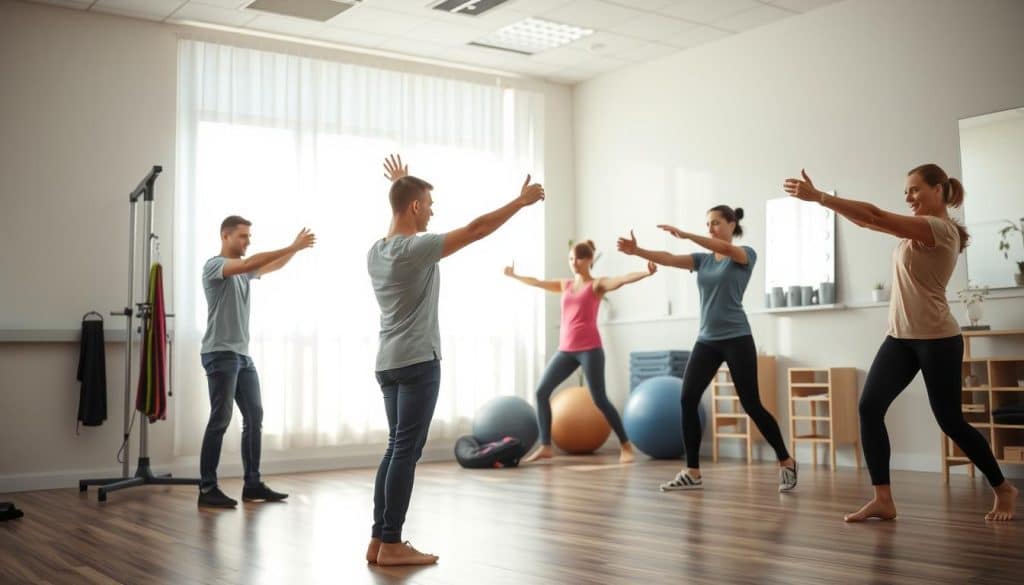After surgery, your body needs careful guidance to heal properly. At Riverside Sports Therapy in Calgary, our team creates personalized plans to help you rebuild strength and flexibility. Whether you’ve had joint replacement, spinal procedures, or orthopedic repairs, starting rehabilitation early can make a big difference in your results.
Managing discomfort is a top priority. Our methods focus on reducing pain while restoring muscle function through targeted exercises and manual therapy. Many patients face challenges like stiffness or limited mobility after surgery—structured sessions address these issues safely and effectively.
Regaining movement isn’t just about healing tissues. It’s about reclaiming your independence. We work with you to improve balance, coordination, and endurance so daily tasks feel manageable again. Call Riverside Sports Therapy at (403) 283-7551 to schedule your first session in Calgary
Key Takeaways
- Early rehabilitation improves long-term recovery outcomes.
- Personalized therapy plans target pain relief and muscle rebuilding.
- Structured sessions help restore mobility and prevent complications.
- Manual therapy and exercises adapt to individual healing progress.
- Starting treatment quickly minimizes stiffness and weakness.
Overview of Post-Surgical Rehabilitation
Every surgical intervention—from orthopedic repairs to abdominal operations—creates unique challenges that demand tailored therapeutic strategies. Rehabilitation focuses on restoring function while managing tissue swelling, pain, and stiffness through evidence-based methods. A well-designed program adapts to your body’s healing timeline, ensuring progress without overexertion.
The Importance of Structured Recovery
Consistency is critical after medical procedures. Structured treatment plans gradually rebuild strength and range of motion through phased exercises and manual therapy. Without guided care, scar tissue may form improperly, delaying healing. Research shows patients who follow systematic programs regain mobility 30% faster than those without professional support.
Common Surgical Procedures and Their Challenges
Orthopedic surgeries often require rebuilding muscle coordination, while cardiac operations need gentle aerobic conditioning. Neurological interventions demand balance retraining, and abdominal procedures focus on core stability. Each scenario requires specific techniques to address tissue repair and prevent long-term limitations.
Customized therapy tackles these hurdles by combining hands-on care with progressive exercises. For example, joint mobilizations improve range of motion after knee replacements, while breathing exercises aid lung capacity post-thoracic surgery. Early intervention minimizes complications, helping you return to daily activities safely.
Understanding the Role of Physiotherapy in Recovery
The body’s natural healing process thrives when supported by targeted movement and expert care. Specialized techniques improve blood flow to injured areas, delivering nutrients that repair tissues faster. This approach also prevents fluid buildup, which can slow progress.
Enhancing Circulation and Healing
Therapists use manual techniques, like gentle massage. These methods stimulate blood vessels near surgical sites. Improved circulation brings oxygen-rich cells to damaged tissues, speeding up repair.
Simple activities maintain joint flexibility without strain. Ankle pumps or arm raises are common starters. Over time, these movements evolve into resistance training to rebuild endurance.
Reducing Pain and Preventing Complications
Customized plans address discomfort through gradual strength-building. Seated leg lifts help after knee procedures while minimizing stress. Swelling reduction combines multiple strategies:
| Technique | Purpose | Benefit |
|---|---|---|
| Manual Lymphatic Drainage | Move excess fluid | Reduces pressure on joints |
| Compression Therapy | Support tissues | Improves circulation |
| Elevation Exercises | Promote drainage | Decreases visible swelling |
Structured routines ease pain and lower risks like blood clots. One study showed patients using guided programs had 40% fewer complications. Tailored exercises adapt weekly to match healing stages, ensuring steady progress.
Post-Surgery Recovery Physiotherapy: What to Expect
The first steps after a medical procedure set the tone for successful rehabilitation. Your initial session focuses on understanding your unique needs while building trust in the process. This visit establishes measurable objectives tailored to your healing journey.
Initial Assessment and Goal Setting
Your therapist begins by evaluating your body’s response to surgery. They measure joint flexibility, identify tender areas, and test basic movements. This helps pinpoint limitations affecting daily activities.
| Assessment Area | Purpose | Tools/Methods |
|---|---|---|
| Range of Motion | Identify stiffness | Goniometer measurements |
| Pain Levels | Track discomfort patterns | Visual analog scale |
| Functional Tests | Assess body stability | Single-leg stance timing |
Clear goals emerge from this data. You might aim to walk 15 minutes without aid or climb stairs safely within 4 weeks. These targets adapt as your body strength improves.
Early treatment focuses on risk reduction. Gentle massage and breathing exercises boost circulation while protecting healing tissues. Modified stretches maintain mobility without strain.
Your therapist introduces simple movement activities during the first week. Seated leg slides or shoulder rolls keep joints active. Each exercise aligns with your healing timeline to accelerate progress safely.
This foundational session creates a roadmap for your rehabilitation. Regular check-ins ensure adjustments match your evolving capabilities and lifestyle needs.
Customized Programs at Riverside Sports Therapy
No two patients share the same path to regaining full mobility after medical procedures. At Riverside Sports Therapy, we craft one-of-a-kind strategies that align with your body’s unique healing needs. Our Calgary team reviews surgical details, current limitations, and lifestyle goals to design programs focused on lasting results.

Personalized Treatment Plans in Calgary
Your treatment begins with a thorough analysis of scar tissue formation and joint mobility. Manual therapy breaks down adhesions gently, restoring smoother movement patterns. As one therapist notes:
“Addressing scar tissue early prevents long-term stiffness—it’s like giving your body a fresh start.”
Key components of our approach include:
- Adaptive exercises: Gradually rebuild strength while respecting tissue sensitivity.
- Dynamic assessments: Weekly check-ins adjust intensity based on progress.
- Functional training: Simulate real-world tasks to help you get back to routines safely.
Manual therapy isn’t just about hands-on care. It’s paired with mobility drills that enhance range motion in stiff joints. For example, shoulder surgeries often require rotational stretches, while hip procedures benefit from guided pelvic tilts.
We blend proven methods with creative problem-solving. Whether you’re recovering from sports injuries or complex operations, our plans evolve as you do. The goal? To bridge the gap between clinical recovery and living life fully again.
Phase-Based Treatment Approach
Structured rehabilitation programs follow a clear roadmap to rebuild strength and confidence after medical procedures. At Riverside Sports Therapy, our three-phase treatment plan adapts to your body’s evolving needs, ensuring steady progress from pain relief to full independence.
Early Recovery Phase: Pain Relief and Mobility Initiation
The first 1-3 weeks focus on reducing discomfort and jumpstarting movement. Gentle techniques like soft tissue massage and passive range-of-motion exercises protect healing areas. For knee procedures, seated leg slides and ankle pumps maintain joint flexibility without strain.
Strength and Range of Motion Phase
Weeks 4-6 introduce resistance training to rebuild muscle. Therapists use elastic bands and bodyweight exercises to strengthen weakened areas. Knee patients often progress to step-ups and mini-squats, improving stability for daily tasks.
Functional Restoration Phase
The final phase (weeks 7+) prepares you for real-world demands. Balance drills, sport-specific movements, and endurance challenges restore full capabilities. A knee replacement patient might practice stair navigation or controlled lunges to regain athletic performance.
| Phase | Focus | Key Techniques |
|---|---|---|
| Early Recovery | Pain management | Manual therapy, ice/heat therapy |
| Strength Building | Muscle activation | Resistance bands, weight-bearing drills |
| Functional Training | Activity simulation | Agility ladders, proprioceptive exercises |
This phased treatment plan minimizes setbacks while maximizing results. Regular assessments ensure exercises match your rehabilitation milestones, creating a safe path to lasting recovery.
Techniques for Effective Pain Management
Managing discomfort after medical procedures requires smart strategies tailored to individual needs. Therapists combine hands-on methods with temperature-based treatments to address different pain types. This balanced approach keeps patients active while supporting tissue repair.
Heat and ice therapies serve distinct purposes during rehabilitation. Ice packs reduce swelling in acute phases, while heat pads relax tense muscles later. Manual techniques like myofascial release break up scar tissue gently, improving joint function.
| Technique | Application | Benefit |
|---|---|---|
| Contrast Therapy | Alternate heat/ice | Boosts circulation |
| Trigger Point Release | Target muscle knots | Restores mobility |
| TENS Units | Electrical stimulation | Blocks pain signals |
Structured programs help patients maintain daily activities without setbacks. A 2023 study showed athletes using guided plans returned to sports 25% faster. Exercises focus on rebuilding strength for tasks like lifting groceries or climbing stairs.
Consistent pain control prevents compensatory movements that strain other body areas. Therapists adjust techniques weekly based on healing progress, ensuring long-term health benefits. This proactive strategy helps patients stay engaged in their recovery journey.
Enhancing Range of Motion and Muscle Strength
Regaining full movement capabilities requires pairing precise strengthening methods with hands-on care. This dual approach addresses both muscle weakness and tissue tightness that often follow medical interventions. Customized strategies ensure progress aligns with each patient’s healing timeline.

Targeted Exercises for Muscle Recovery
Structured routines rebuild strength while improving joint flexibility. Resistance bands and bodyweight squats activate dormant muscles without straining healing areas. For example, shoulder blade squeezes enhance upper back stability after chest procedures.
Balance drills like single-leg stands or wobble board exercises retrain coordination. These activities challenge stability systems weakened by inactivity, reducing fall risks during daily tasks.
Manual Therapy and Soft Tissue Treatments
Hands-on techniques break down adhesions restricting movement. Therapists use myofascial release and joint mobilizations to improve tissue glide. One study found combining these methods with exercise boosts flexibility by 40% compared to standalone workouts.
Soft tissue work also enhances blood flow to stiff areas. This accelerates nutrient delivery to muscles, supporting faster repair. As one expert notes:
“Manual therapy isn’t just about mobility—it prepares tissues to respond better to strengthening efforts.”
Physiotherapists continually adjust these techniques based on progress assessments. Whether recovering from joint replacements or spinal operations, patients benefit from this integrated path to renewed independence.
Role of Manual Therapy and Advanced Techniques
Expert hands-on care bridges the gap between surgical healing and functional freedom. Specialized techniques target hidden barriers like muscle tightness and restricted joint mechanics. These methods restore natural movement patterns while respecting tissue sensitivity.
Breaking Down Barriers to Mobility
Therapists use precise pressure and guided movements to relieve tension. Joint mobilizations gently glide stiff areas through their natural range of motion. This approach improves circulation and reduces protective muscle guarding.
| Technique | Application | Benefit |
|---|---|---|
| Grade IV Mobilizations | Stiff shoulders/hips | Enhances joint motion |
| Myofascial Release | Tight surgical scars | Restores tissue flexibility |
| Muscle Energy Techniques | Pelvic imbalances | Balances muscle length |
Scar tissue management begins early to prevent long-term stiffness. Cross-friction massage breaks up adhesions while promoting collagen alignment. Patients often regain 20-30% more flexibility after 4 weeks of treatment.
Every therapy plan adapts to individual healing milestones. A knee replacement patient might receive patellar glides, while spinal surgery cases focus on segmental mobilizations. As one therapist explains:
“Manual therapy isn’t just about moving joints—it’s about rewiring how the body perceives safe movement.”
Strategic scheduling ensures techniques build on each other. Early sessions prioritize pain-free motion, while later phases challenge flexibility through progressive stretches. This personalized approach minimizes setbacks and accelerates functional gains.
Lifestyle Adjustments to Accelerate Healing
Your daily choices play a vital role in how quickly and effectively your body heals. Combining clinical treatments with smart lifestyle habits creates a powerful synergy for achieving rehabilitation goals. Let’s explore practical steps people can take to support their healing journey.
Fueling Recovery Through Nutrition
A balanced diet rich in protein, vitamins, and minerals provides building blocks for tissue repair. Hydration maintains cellular function and helps flush out toxins. Consider these key nutrients:
- Protein: Supports muscle rebuilding (aim for 20-30g per meal)
- Vitamin C: Boosts collagen production for wound healing
- Zinc: Strengthens immune function during healing
Home Exercise Essentials
Guided home programs extend the benefits of clinical treatments. These targeted movements maintain progress between therapy sessions while preventing stiffness. A 2023 study showed people who combined clinic and home exercises met mobility goals 35% faster.
| Exercise | Focus Area | Frequency |
|---|---|---|
| Wall-Assisted Squats | Lower Body Strength | 2x daily |
| Shoulder Blade Slides | Upper Body Mobility | Every 2 hours |
| Ankle Alphabet Tracing | Joint Flexibility | 3 sets/day |
Consistency matters more than intensity. Even 5-minute movement breaks every hour improve circulation without overtaxing healing tissues. As one patient noted:
“Following my home plan made me an active participant in recovery – I could see measurable progress each week.”
Small lifestyle changes create big impacts. Prioritizing sleep, managing stress, and avoiding smoking all contribute to better treatment outcomes. When people take ownership of these daily habits, they often surpass their initial rehabilitation goals.
How to Book Your Assessment in Calgary
Starting your healing journey begins with one simple step. Riverside Sports Therapy makes it easy to schedule your initial evaluation through flexible booking options. Early action helps maximize results while tissues are most responsive to treatment.

Contact Information and Scheduling Options
Call (403) 283-7551 to speak directly with our Calgary team. We answer questions about insurance coverage, session timing, and what to bring. Prefer online booking? Visit our website’s scheduling portal for 24/7 access.
| Method | Steps | Benefits |
|---|---|---|
| Phone | Discuss availability with staff | Personalized time slot recommendations |
| Online | Complete intake form + pick time | Instant confirmation email |
A personalized treatment plan gets created during your first visit. This roadmap addresses specific mobility challenges while building confidence in your progress. Therapists assess strength range motion through functional tests, then design exercises matching your capabilities.
Beginning post surgical rehabilitation quickly prevents stiffness and muscle loss. Studies show starting within 72 hours improves strength range motion by 18% compared to delayed care. Our team prioritizes early openings for new patients to support optimal healing.
Don’t wait—secure your spot today. Whether recovering from joint procedures or cardiac operations, structured guidance makes all the difference. Take charge of your post surgical rehabilitation journey now.
Conclusion
Navigating the journey back to full mobility requires expertise tailored to your body’s unique healing process. At Riverside Sports Therapy, our Calgary team combines advanced techniques with compassionate care to help patients thrive after medical procedures. Structured programs address soft tissue repair, joint flexibility, and functional strength through phased rehabilitation plans.
Manual therapy plays a crucial role in restoring movement patterns disrupted by surgery. Targeted treatments break down scar tissue adhesions while improving circulation to damaged areas. This hands-on approach, paired with progressive exercises, helps rebuild confidence in daily activities.
Personalized strategies extend beyond clinic sessions. Nutritional guidance and home exercise routines support tissue regeneration between appointments. Patients who embrace these adjustments often achieve milestones faster while reducing reinjury risks.
Ready to take control of your post-surgical rehabilitation? Call Riverside Sports Therapy at (403) 283-7551 today. Let our experts design a recovery plan that aligns with your goals and accelerates your return to an active lifestyle.
